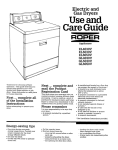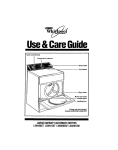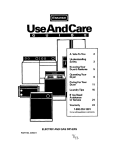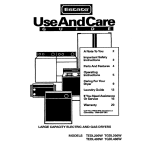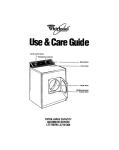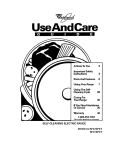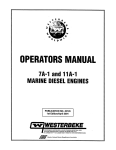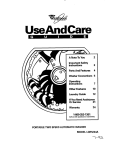Download Roper GL5030V Operating instructions
Transcript
UseAndCare A Note To You 2 PartsAnd Features 4 Operating Instructions 5 Caaig For Your 13 Laundry Guide 17 If You Need Assistance orsen/ice 20 Warranty 24 Cdl TW-FREE Wh babotts common& %8004-ROPER or LARGE CAPACITY ELECTRIC AND GAS DRYERS MODELS EL4030V EL5030V EL6050V GL4030V GL5030V GL6050V A Note To You Thank you for buying a Roper appliance. You have purchased a quality, B&&&S home appliance. Years of engineering experience have gone into its manufacturing. To ensure that you will enjoy many years of trouble-free operation, we have developed this Use and Care Guide. It is full of valuable information on how to operate and maintain your appliance property and safely. Please read it carefully. Also, please complete and mail the Cwnership Registration Card provided with your appliance. Your safety is important to us. This guide contains safety symbols and statements. Please pay special attention to these symbols and folbw any instructions given. Here is a brief explanation of the use of each symbol. This symbol will help alert you to such dangers as personal injury, burns, fire and electrbal shock This symbol will help you avoid actions which could cause product damage (scratches, dents, etc.) and damage to your personal property. Our TOLL-FREE number, l-60044-ROPER available 24 hours a day. (l-800-447-6737), is lf you ever have a question concerning your appliance’s operation, or if you need service, feel free to call us for help. When calling, you will need to know your appliance’s complete model number and serial number. You can find this information on the model and serial number label (see diagram for your model on page 4 or 5). For your convenience, we have included a handy place below for you to record these numbers, the purchase date from the sales slip and your dealer’s name and telephone number. Keep this bode and the sales slip together in a safe place for future reference. Model Number Dealer Name !%lal Number Dealer Phone Purchase Date FOR YOUR SAFETY If you smell gas: 1. Open wlndows. 2. Don’t touch electrlcal switches. 3. Extlngulsh any open flame. 4. lmmedlately call your gas suppller. 2 FOR YOUR SAFETY Do not store or use gasollne or other flammable vapors and llqulds In the vlclnlty of thls or any other appliance. The fumes can create a flre hazard or exploslon. ImDortant Safetv Instructions To reduce the risk of fire, electrical shock, or injury to persons when using your dryer, follow basic precautions, including the following: Read all InstructIons before using the dryer. l NEVER dry items deaned, washed, soaked in or spotted with wax, paint, gasoline or flammable fluids in the dryer. The fumes can create a FIRE HAZARD or EXPLOSION. ALWAYS hand launder and air dry fabrics containing these materials. l NEVER allow children to operate, play with or crawl inside the dryer. Close supervision of children is necessary when the dryer is used near children. l DO NOT reach into a dryer if the drum is moving. l When discarding an old dryer, ALWAYS remove the door to prevent accidental entrapment. . DO NOT install or store dryer where it will be exposed to the weather. l DO NOT tamper with the controls. l You are r88pOnSible for maklng 8ur8 that your dryer is installed, repaired and has parts replaced by a qualified person. l Use only fabric softeners specifically labeled as not being harmful to the dryer. . RRE HAZARD and DAMAGE to materials can result from: -drying rubber, rubber-like and heat sensitive materials with heat. -allowing lint build-up inside the dryer or exhaust system. Cleaning should be done periodically by a qualified person. l Clean lint screen before or after each load. l DO NOT let dust, lint, paper, rags, chemicals, etc. pile up around or under the dryer. l Dryer must be electrically grounded. See the Installation Instructions. l - SAVE THESE INSTRUCTlOf4S - Additional safety responsibilities instructions . NEVER operate the dryer if: -II is not working right (i.e. noisy, too hot). -it is damaged. -parts are missing (i.e. door latch). -all panels are not in place. -the lint screen is loose, damaged or missing. l ALWAYS shut off the gas valve before leaving on vacation if you have a gas dryer. l ALWAYS unplug the power supply cord or turn off electrical power before attempting to service the dryer. Shut off GAS VALVE if you have a gas dryer. l You 8re responsible for maklng 8ur8 that your dryer: -is properly maintained. and your -is property installed and leveled on a floor that can support the weigM in a well ventilated mm.* - is located in an area where the temperature is above 45OF(7°C). - is conneded to the proper outlet and electrical supply.’ - is properly connected to fuel and exhaust systems.’ - is not installed against drapes or curtains.’ - is used only for jobs normally expected of home cbthes dryers. - is not used by anyone unable to operate it PropedY. *See the Installation Instructions for complete information. 3 Parts And Features Your dryer’s parts and features are illustrated in this section. B-me before king your appliance. Models EL4030V and GL403OV Control panels EL4030V and GL403OV EL5030V and GL503OV Models familiar with all parts and features EWOBOV and GL503OV Models EL6050V and GL605OV Control panel EL6050V and GL605OV Operating Instructions I I In This Section Starting your dryer .-. --ll........l POW ---I6 CydesEL4O3OV and GL402OV M...............--.Q lJslngdampdry,-- -...--I ----11 The no hsat fluff cycle3 or Mting ,----.l Gydeo-ELWOV, QL503OV,EIAOSOVand GL605OV.@ End-ofeyde lJ8lng mlnkla free..-....,.,.---...---.10 osntb l lgnnl Pa* I 1 ..---,-e--w.-12 halt 8y8tem -..--~-~~.--...12 Your Roper dryer is designed for ease of operation and maximum drying efficiency. This section gives you important information for efficient and safe use of your dryer. NOTE: Do not remove any permanent instruction labels inside the dryer. You should wipe out the dryer drum with a damp cloth before using to remove dust from storing or shipping. ff your dryer has a Consumer Buy Guide label, remove it. lt will be easier to remove before the dryer is used. To remove any remaining glue: l Rub briskly with thumb to make a ball, then Do not use sharp instruments, rubbing alcohol, remove. flammable fluids or abrasive cleaners. These can damage the finish. See ‘Important Safety OR Instructions’ on page 3. l Soak area with liquid hand dishwashing detergent before removing glue as described above. 5 Starting your dryer Be sure to refer to the chart below for proper sorting, loading and control setting information before starting your dryer. NOTE: Do not overdry. Overdrying can cause shrinkage, static din& and damage some fabrics. CYCLE TIME-TEMP (EL403OV, GL403OV) TYPE OF LOAD COITONS AND LINENS Extra Heavy-5edspreads. mattress pads, quilts Heavyweight-Towels, jeans, ccrduroys, work SI’FCM’ DW CYCLE TIME-TEMP (ELSMOV, GL503OV) CYCLE TIME-TEMP (ELt%lW, GL6OSOV) AUTOSENSECotton Perm’t Press High Cotton Perm’t Press High Cotton High Mad-Normal cotton Perm’t Press High Pwm’t Press Medium Light-Knits Low Knits Lclw Ex Heavy-Normal Heavy-Normal Cotton High dOltWS M&umweightShwts, pillowcases, cotton underwear, diirs Lightweight-Satistes, organdiis, lingerie PERMANENT PRESS, SYNTHETICS AND BLENDS Heavyweight-Work clothes, jackek, raincoak Mediumweight-Shirts, play dcthes. sheets, slacks Lightweight-Lingerie, blouses, dresses PFRK PR’=SS 40-50 min-Normal 30-40 min-Normal 2%30 min-Knits Low KNITB Heavyweight-Cottons, myons. bknds. T-shirts. skJcs,~shirts lvlediumweigh~r (Pd&s~*-Yl~‘-s PFRW PRFSS 40-50 min-Normal Lightwe~ght&nthetics (potyester, acrylic, etc.) and blends, lingerie, blouses, dmsses DEUCATE FABRICS Sheefcunains(2or3penets), Low AUTO-SENSE AUTOSENSE PFRW PR’=sS PFRm PRFSS Cotton Penn? Press High Cc&n Perm’t Press High Knik Low Penn1 Press Medium Pemtl Press Medium Medium Low AUTO-SENSE AUTO-SENSE PFRM PRFSS titb3n Penn? Press PFRm f’R’=SS 30-40 min-Normal High Knik Low Perml Press Medium Medium Low 20-30 min-Knits Low Knik Low Knik Delicate Low PFRM PRFSS 15-20 min-Knits Low gauze, lace. etc. Knik Deliite AUTMNSE AUTOSENSE PFRM PRFSS PFRM pR’=SS Knik Lovv EXLOW Fire Hazard Drying rubber, plastic and other heat-sensitive damage them or be a FIRE HAZARD. RUBBER, PLASTIC, HEAT-SENSITIVE FABRICS Foam RubberPillows, bras, stuffed toys Plastic-Shower curtains, PFRM PRFSS No Heat Fluff l 2o-30 min NoHeatFtuff’ 2040 min materials with heat can NO” 2o-30 min 20-30 min 2030 min 2040 min 4MO min 1520 min 4&50 min 15-20 min 4060 min 16-20 min b3M6CJOUlS Rubber-Backed rugs 3lefin, Polypropylene. Sheer nylon SeleCtEd. 6 Cyde is unheated. EL403OV and GLM3OV EL503OV and Gl503OV EL60!5OVand GUO5OV 7 EL503OVand Gl5030V l nd GMOSOV EL6OSOV 3. Push the Start Button to start the dryer. To stop and restart the dryer: l Open the door or turn the Cycle Control Knob to OFF to stop the dryer. l Cbse the door, select a cycle (if necessary) and push the Start Button to restart the dryer. To change the cycle and/or time, turn the Cycle Control Knob either way to point to a new setting. The Cycle Control Knob should point to an OFF area when the dryer is not in use. If the dryer is stopped before the cycle is finished turn the Cycle Control Knob to an OFF area. 6 Cycles-EL4030V Regular and GL403OV cycles The regular cydes describe the types of bads they are designed to dry. Each cyde is followed by a 5 minute ml-down period. During the cool down, the bad tumbles without heat. This helps make the bad easier to handle. Use EX HEAVY to dry items such as bedspreads, mattress pads and quilts. Use HEAVY to dry such kerns as towels, jeans, corduroys and work clothes. Use MED to dry items such as sheets, pilbwcases, cotton underwear and diapers. Use LIGHT to dry batistes, organdies and lingerie. For the first few bads, set the Cycle Control Knob to point to a line at a cyde in SPECfAL DRY. When the dryer stops, feel the drbd items. l If the items are drier than you like, set the Cycle Control Knob more to the right the next time you dry a similar load. l ff the items are not as dry as you like, set the Cycle Control Knob more to the left the next time you dry a similar bad. NOTE: Overdrying can cause shrinkage, static cling and damage to some fabrics. The PERMANENT PRESS cycle The PERMANENT PRESS cycle helps provide the special care that permanent press and synthetic fabrics need. The cycle consists of a timed period of heated drying and a 10 minute cooldown period. During the cool down, the bad tumbles without heat. This helps keep wrinkles from setting and makes the bad easier to handle. NOTE: To help reduce wrinkling, remove the bad from the dryer as soon as tumbling stops. This is important for permanent press, knits and synthetic fabrics. Cycles=EL503OV, GL605OV The automatic GL503OV, cycles The automatic cydes let you select the degree of dryness you want. A thermostat senses the air temperature and automatically shuts the dryer off when the selected dryness is reached. Use AUTO-SENSE HEAVY to dry heavy and mediumweight cotton items. The bad tumbles without heat during the last 5 minutes. This helps make the bad easier to handle. EL6050V and Use AUTO-SENSE PERMANENT PRESS to dry permanent press, knits and other synthetic items. The bad tumbfes w&out heat during the last 10 minutes. This helps keep wrinkles from setting in and makes the bad easier to handle. For the first few bads, set the Cycle Control Knob to point to NORMAL DRY in either auto matb cycle. When the dryer stops, feel the dried items. l lf the items are drier than you like, set the Cycle Control Knob more to the right of NORMAL DRY the next time you dry a similar bad. l tf items are not as dry as you like, set the Cycle Control Knob more to the left of NORMAL DRY the next time you dry a similar bad. EL6MOV l d GL6OSOV NOTE: Overdrying can cause shrinkage, static cling and damage to some fabrics. TIMED DRY Use the TIMED DRY cycle for any bad you want to dry by time. Turn the Cycle Control Knob to the number of minutes you want from 10 to 60 or 70. The last 5 minutes of this cycle are without heat to help make the bad easier to handle. ELSOWVl d GL503OV ELWiOV l d GL6OSOV Using WRINKLE FREE The WRINKLE FREE setting removes wrinkles from cbthing that has been packed in a suitcaee or closet. and from items not removed from the dryer at the end of a cyde. 1. Set the Cycle Control Knob on WRINKLE FREE. 2. Set the Temperature Selector on KNfTS LOW or KNfTS DELICATE LOW. 3. Push the Start Button. The bad will tumble in heated air for 15 minutes. Then the dryer will tumble the clothes for 5 more minutes without heat. For best results, put only a few items at a time in this cycle. As scbn as the dryer stops, put the items on hangers or fob them. 10 Using DAMP DRY Use this setting to damp dry hems that do not require an entire drying cycle, or to dry items to damp level. (Two examples are heavy cottons, such as jeans, which you do not want to become stiff, or cotton clothes which are easier to press when damp.) 1. Set the Cycle Control Knob on DAMP DRY. 2 Push the Start Button. The bad will tumbfe in heated eir for 20 minutes, then without heat for 10 minutes. The NO HEAT FLUFF cycle The dryer does not heat when the Temperature Selector is turned to NO HEAT FLUFF (EL403OV, GL403OV. ELXXMV and GLSO3OV), or the Cycle Control Knob is turned to NO HEAT/FLUFF (EL6050V and GL6050V). NO HEAT FLUFF can be used to fluff or air dry bedding, plastic tabbcbths. foam rubber pillows. stuffed toys, sneakers, etc. For models GL403OV EL4030V and Turn the Temperature Selector to NO HEAT FLUFF and the Cycle Control Knob to the number af minutes you want in the PERMANENT PRESS cycle. Then push the Start Button. NOTE: Repeat above steps if more time is needed. or setting For models GL503OV EL5030V and Turn the Temperature Seledor to NO HEAT FLUFF and the Cycle Control Knob to the number of minutes you want in the TfMED DRY cyde. Then push the Start Button. NOTE: Repeat above steps if more time is needed. EL503OV and GUO3OV For models GL605OV EL6050V and Turn the Cycle Control Knob to the desired minutes you want in the NO HEAT/FLUFF cycle. Then push the Start Button. NOTE: Repeat above steps if more time is needed. ELWSOV md GLWWV End-of-cycle For models GL605OV EL6050V signal and The dryer sounds a signal to let you know when the cycle is finished. The signal cannot be turned off and is not adjustable. The signal is helpful when you are drying permanent press, synthetics and other items that should be taken out as soon as the dryer stops. Gentle For models GL605OV Heat system EL6050V and For better fabric care, the Gentle Heat system helps prevent overdrying. Drying temperatures are automatically reduced to a lower heat setting during the last few minutes of drying. Gentle Heat is followed by a cool-down perii in all cycles to make your clothes easier to handle. 12 ‘5’ =9 / \ 3\ Caring For Your Dryer In This Section Unt l awn mP PaWJ Cleaning the llnl screen “---,--““.“...13 malnIenance -l.........-...-l.... Cleaning the dryer --..----....---14 13 Unt removal -..- -,---------.15 Do not run the dryer with the lint screen loose, damaged, bbdred or missing. Doing so can cause overheating and damage to both the dryer and fabrics. Cleaning the lint screen The lint screen is &ated under a lid on top of the dryer. Clean lt before each load. A screen blocked by lint can increase drying time. 1. C$n the lid and pull the lint screen straight 2. Roll lint off the screen with your fingers. Do not rinse or wash the screen to remove lint. Wet lint is hard to remove. 3. Push the lint screen firmly back into place and close the lid. Lint screen maintenance Laundry detergents and fabrfc softeners can cause a residue build-up on the lint screen. A clogged lint screen can extend drying times. Clean the lint screen every six months or more frequently if it becomes clogged due to a residue build-up. Use the following method: 1. Wet both sides of lint screen with hot water. 2. Wet a nybn brush with hot water and liquid detergent. 3. Scrub lint screen with the brush until all residue build-up is removed. 4. Rinse with hot water. 5. Thoroughly dry lint screen with a dean towel and replace in dryer. 13 Cleaning the dryer ElectrIcal Shock and Personal Injury Hazard l Turn off the electrical power before cleaning the interior. l Make sure the dryer is cool. Failure to do so could resutt in electrbal shock or injury. Fire Hazard l Use non-flammable cleaner. Failure to do so could result in an explosion. Garments which contain unstable dyes, such as denim Mue jeans or brightly colored cotton items, may discolor the dryer interior. If you want to remove stains from dryer drum use one of the following methods: Powdered laundry detergent 1. Make a paste with detergent and very warm water. 2. Apply paste to a soft cbth and scrub area until all excess dye is removed. 3. Wipe thoroughly with a damp cloth. 4. Tumble a bad of rags to dry. Llquld non-flammable household cleaner 1. Apply to stained area 2. Rub with a doth until all excess dye is removed. 3. Wipe thoroughly wfth a damp cloth. 4. Tumble a bad of rags to dry. To clean dryer exterior: Wipe with a soft, damp doth. 14 Lint removal Lint can gather inside the dryer and be a fuel for fire. lt is recommended the lint be removed every 2 to 3 years, or more often, depending on dryer usage. Cleaning should be done by a qualified person. lf you have any questions. please call our Consumer Assistance Center at 18OM476737. Electrlcal Shock and Personal Injury Hazard l Unplug the power supply cord or turn off the electrical power before removing dryer panels. l Make sure the dryer is cool. l Dryer parts can have sharp edges. Use care when handling. l When replacing front panel after lint removal, the wire clips holding the door switch wires must be anchored to top of front and side panels. Wires MUST NOT touch rotating drum. (See page 16, step 7.) Failure to do so could result in electrical shock or personal injury. If your dryer is electric, or is gas and has a lower front access panel: 1. Unplug the power supply cord or turn off the electrical power. 2. Remove badt panel (electric) or bwer front access panel (gas). Sea Installation Instructions. 3. Remove lint from shaded area in illustration with a soft brush or vacuum cleaner. Avoid damaging wires, thermostats (electric), funnel (gas) or igniter (gas). 4. Replace panel; reconned and level dryer again, if necessary. Ekblc dryer with bsck pand removed NOTE: See page 16 if your dryer is gas and has a full front panel. Gas dryer with lower front acms8 panel removed 15 If your dryer is gas and has a full front panel, remove front panel as follows: 1. Unplug the power supply cord or turn off the electrical power. 2. Open lint screen lid. Remove two screws from lint screen area. 3. Cpen top by pulling forward and up at each front corner (see view A). Rest raised top against wall behind dryer (top is hinged at rear). 4. Remove two internal screws from front panel flanges (near top front comers). Lii front panel slightly, lifting off lower dips (see view B). Slowly pull front panel forward, disengaging panel from drum. (Drum will drop slightly.) 5. Move front panel aside and rest edge against side of dryer. Avoid disconnecting wire clips (see view C) or damaging wires. 6. Remove lint from area shown in “gas dryer illustration on page 15 with soft brush or vacuum deaner. Avoid damaging wires, funnel or igniter. 7. Reassemble in reverse order. Before closing the top, check the following: - Drum seal must be flared out (see view D) and properly positioned against panel at back of drum. Rotate drum countercbckwise one full turn to check drum seal. - Belt should be centered and tight on dryer drum. - Wire clips which hold the door switch wires must be anchored in sbt in top of front panel (see view C) and abng top edge of side panel. Door wires must not touch drum when dryer is operating. See Warning, page 15. 8. Replace top panel and lint screen screws. Top and front panels must be securely in place before operating dryer. 9. Reconnect power and level dryer again (ii necessary). A Drum 00~1 8ldel panel Wire diphotdsdoor View8 NOTE: Call Consumer Assistance at l-800-447-6737 for assistance or more information. VIewD 16 Removsecrewr betom opening 1op Laundry Guide In This Section Paw Common kundeuing problano ..---I...YY 17 19 ww upr “..““...a.......“-.....-..“....-....~....~ Dryer fabric Mftners ...... ........... ............. .. ....-I9 mF Energy aavfng tlpa “I ...- “I._.... I......._... “.19 Vacalion m I .. ..-..-...-..“---..” . . .. . 19 This section will help you solve laundry problems and improve your drying results. Common PROBLEM Greasy spots laundering problems CHECK IF CAUSEYSOLUTlONS Dryer fabric softeners were used Undiluted washer fabric softener was used Enough detergent was used items were clean before they were dried Llnt Lint screen is clogged Load is properly sorted Static electriciiy is attrzting lint Load is too bii or heavy Paper or tissue was in pocket Enough detergent was used Pilling is being mistaken for lint Folbw manufacturer’s product directions carefully. Dilute fabrii softener before adding to the final rinse. Use enough detergent to hold soil in the wash water until it drains away. Undrained soil can stick to outer tub of the washer and cause greasy spots with next load. Soiled items can stain other items in the bad. They can also leave stains on the dryer drum that can bs picked up by items in later bads. Dryer heat may permanently set these stains. Clean lint screen. (See page 13.) Sort lint-givers (bath towels, etc.) from lint-takers (synthetics, permanent press). Use fabric softener in the washer’s final rinse. Use correct dryer settings for fabric. Overdrying synthetics can cause lint-attracting static electric@ Dry smaller bads. When items can’t tumble freely, air is unable to carry lint to lint screen. Empty pockets carefully. A small scrap of paper can cause a lot of lint. Use enough detergent to hold the lint in the water until it drains away. Base detergent amount on water hardness and soil in wash bad. Pilling (surface fuzz) is caused by normal wear and laundering. Pills do not break away easily from the fabrii and can often collect lint. Synthetic fabrics are more likely to pill than others, especially at neckbands, elbows and knees. continued on next page 17 PROBLEM Shrlnklng CHECK IF items are overdried Fabric type and quality is suitable for drying Slow drying There is a large amount of moisture in the bad to be dried Cold rinse water is used Room air temperature is below 45°F (7%) Dryer is exhausted according to Installation Instructions Lint screen is cbgged Exhaust duct or outside exhaust hood is clogged Proper electrical supply ia used Statk electrktty Load is overdried Fabric softener is used Synthetics, synthetic blends, permanent press and knits are in bad 1R CAuSwSOLunONs Remove kerns while there is still a trace of moisture. Some items should be removed while damp, then shaped and air dried. Some knits are stretched during manufacturing. Washing and drying returns them to the original size. This is normal. Check quality of garment before buying. Folbw fabric care label directions carefully. Some items hold more moisture than others (cottons more than polyester). They take bnger to dry. Full bads take bnger to dry than small bads of the same fabric. A bad rinsed in cold water will take slightly bnger to dry than a warm one. Cold rinses, however, help save energy and reduce wrinkling more than warm rinses do. Install dryer in a room where the air temperature is warmer than 45°F (7°C). Cold air increases drying time and may CiuIse wrinkles not to be removed. Install and exhaust your dryer according to the Installation Instructions provided. Clean lint screen before or after each use. Clean if needed. Properly connect the dryer to a ’ grounded electrical circuit that meets the electrical requirements stated in the Installation Instructbns. Remove items while there is still a trace of moisture. Use fabric softener and follow package directions carefully. Synthetics, synthetic blends, permanent press and knits build up static electricii. Use a fabric softener and be careful not to overdry the bad. Drying l l tips Articles to be ironed should be removed from the dryer while still damp. Dry only clean items. Soiled items can leave stains on the dryer drum. These stains can be picked up by other items in the bad. Dryer heat may permanently set some stains. Dryer fabric softeners Dryer rubric softeners are recommended for reducing static cling and for softening fabrics. Always follow package instructions carefully. NOTE: Static can also be reduced by not overdrying. l For best results, put fabric softener sheet on top of the bad before startfng the dryer. DO NOT add a fabric softener sheet after the cycle has started. Instant heat can cause the fabric softener to spot fabrics. l Clear, grease-like spots can resutt from the fabric softener sheet becoming tangled or wrapped in an item during tumbling. tf fabric softener causes a stain, wet the stain and rub with liquid detergent or bar soap then wash. l Some dryer fabric softeners can dog the lint screen and slow drying. Use only fabric softeners labeled as dryer safe. Energy l l l l saving tips Dry only full loads without overdrying. Avoid overloading dryer, adding wet items to a partly dried load, or opening the door unnecessarily. Plan your laundry to dry one load after another. A warm dryer shortens drying time. Shorten drying times by: -keeping the lint screen dean. -using your dryer in a room where room air temperature is above 45°F (7°C). -exhausting dryer properly. -sorting bads by fabric weight and type. Vacation care 1. Unplug power supply cord or turn off electrical power supply. Shut off supply GAS VALVE if you have a gas dryer. 2. Clean lint screen. 19 If You Need Assistance Or Service This section is designed to help you save the cost of a service call. First we outline possible problems, their causes and their solutions. However, you may still need assistance or service. When calling our Consumer hsistance Center for help or calling for service, you will need to provide a complete description of the problem, your appliance’s complete model and serial numbers and the purchase date. (See page 2.) This information is needed to respond to your request properly. 1. Before calling for assistance .-. Performance problems often result from liile things you can find and fix without tools of any kind. Please check the chart below for problems you can fii. lt could save you the cost of a service call. PROBLEM Dryer will not run. CHECK IF Power cord is plugged into a live circuit with proper voltage. Dryer door is closed. Start button is pushed firmly. Controls are set in a running or ON position. Home’s main fuse has blown or circuit breaker has tripped. Also check if a timedelay fuse or circuit breaker has been used. Dryer will not heat. Turn cycle control knob to OFF. Replace fuse with a timedelay fuse of the coned capacity. Reset circuit breaker. Reset controls and push start button. Reset cycle control knob or temperature selector to heat setting. Wait for cycle to finish. Home’s main fuse has blown or circuit breaker has tripped. Also check if a timedelayed fuse or circuit breaker has been used. Turn cycle control knob to OFF. Replace fuse with a timedelayed fuse of the coned capadty. Reset circuit breaker. Reset controls and push start button. The circuit supplying an electric dryer uses 2 breakers or 2 fuses. lf one breaker has tripped or one fuse has blown, the dryer may run, but not heat. Turn cycle control knob to OFF. Open gas valves. Wail 5 minutes. Reset controls and push start button. Lint screen is clean. Exhaust dud or outside exhaust hood is clogged. 20 Turn cycle control knob to OFF. Firmly plug cord into electrical outlet. Check circuit voltage at fuse/circuit breaker box. Reset c;ontrols and push start button. Close door firmly. Push start button. Set controls and push start button. Cycle control knob or temperature selector is set on NO HEAT FLUFF. Heat cycle is in its last minutes (there is no heat during that time). Gas shutoff valves are open both on dryer and on supply line if yours is a gas dryer. Drying time too long. SOLUllON Clean lint screen. See instructions on page 13. See ‘Slow drying’ section of table, page 18, for additional information. Clean if needed. 2. If you need assistance Call our toll-free telephone number. Dial free from anywhere In the U.S.: l-80044-ROPER (1-600-4474737) and talk with one of our trained consultants. The consultant can instruct you in how to obtain satisfactory operation from your appliance or, if service is necessary, recommend a qualified service company in your area. For further information, write to: Mr. William Clark Consumer Assistance Representative Roper Brand Appliances 2000 M-63 Benton Harbor, MI 49022 Please include a daytime phone number in your correspondence. 3. If you need service 4. If you are not satisfied how the problem was solved . . . ... ... Contact the dealer from whom you purchased the appliance or the authorized servicer in your area. For help finding an authorized servicer in your area, call our toll-free telephone number in Step 2. l l l with Contact the Major Appliance Consumer Action Panel (MACAP). MACAP is a group of independent consumer experts that voices consumer views af the highest levels of the major appliance industry. Contact MACAP only when the dealer, authorized servicer and Roper Brand Appliance warrantor have failed to resolve your problem. Major Appliance Consumer Action Panel 20 North Wacker Drive Chicago, IL 60606 MACAP will in turn inform us of your action. a ROPER” Dryer Warranty LENGTH OF WARRANTY WHAT WE WILL PAY FOR FULL ONE-YEAR WARRANTY (from date of purchase) Replacement parts and repair labor to correct defects in materials or workmanship. Service must be provided by an authorized Roper service company. WHAT WE WILL NOT PAY FOR A Service calls to: 1. Correct the installation of your appliance. 2. Instruct you how to use your appliance. 3. Replace house fuses or correct house wiring or plumbing. 4. Replace owner accessible lght bulbs. B. Repairs when appliance is used in other than normal, single-family household use. C. Pickup and delivery. Your appliance is designed to be repaired in the home. D. Damage to appliance caused by accident, misuse, fire, flood. acts of God, or use of products not approved by us. E Repairs to parts or systems caused by unauthorized modifications made to the appliance. This Roper appliance is warranted by Whirlpool Corporation. Under no circumstances shall it be liable under this warranty for incidental or consequential damages and all implied warranties are limited to the same time period stated in the express warranties for Roper Brand Appliances. Some states do not allow the exclusion or limitation of incidental or consequential damages, so this limitation or exclusion may not apply to you. This warranty gives you specific legal rights, and you may also have other rights which vary from state to state. Outside the United States, a different warranty may also apply. For details, please contact your authorized Roper distributor or military exchange. If you need service, first see the ‘Assistance and Service” section of this book. After checking ‘Assistance and Service,’ additional help can be found by calling our toll-free telephone number, 1400-44-ROPER (1-8004476737), from anywhere in the U.S. PART NO. 3395420 019S2whl~corpaatbtl Ptinlled h USA
























